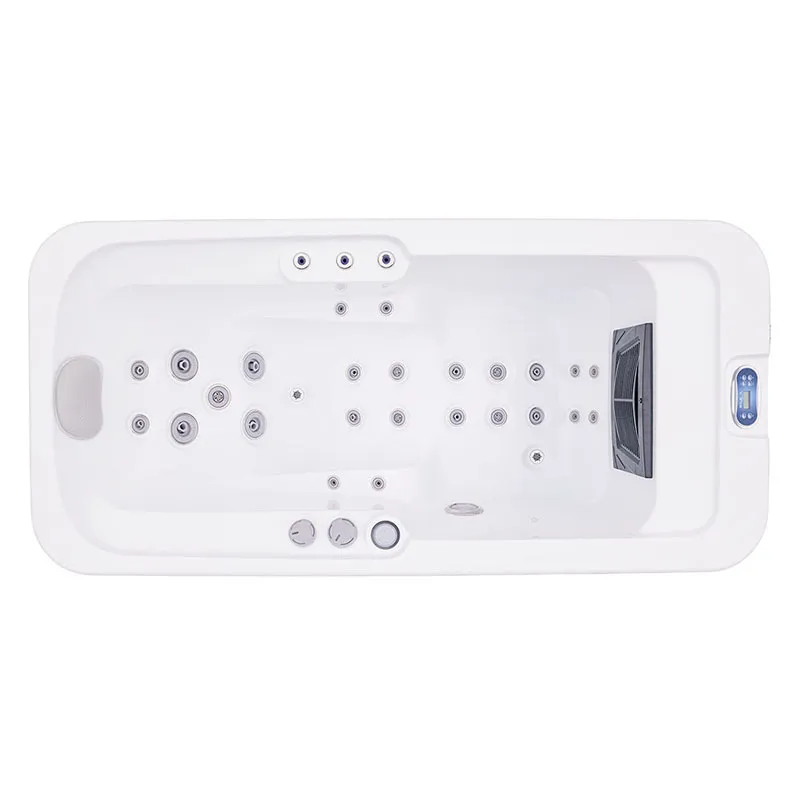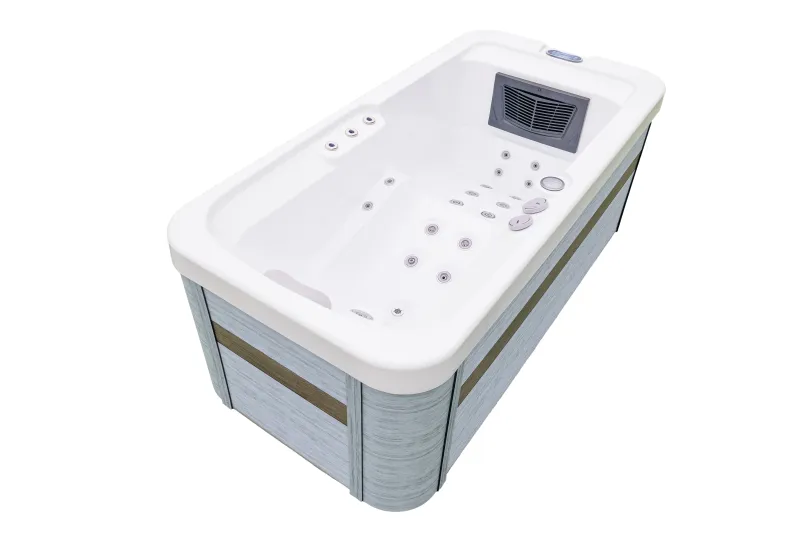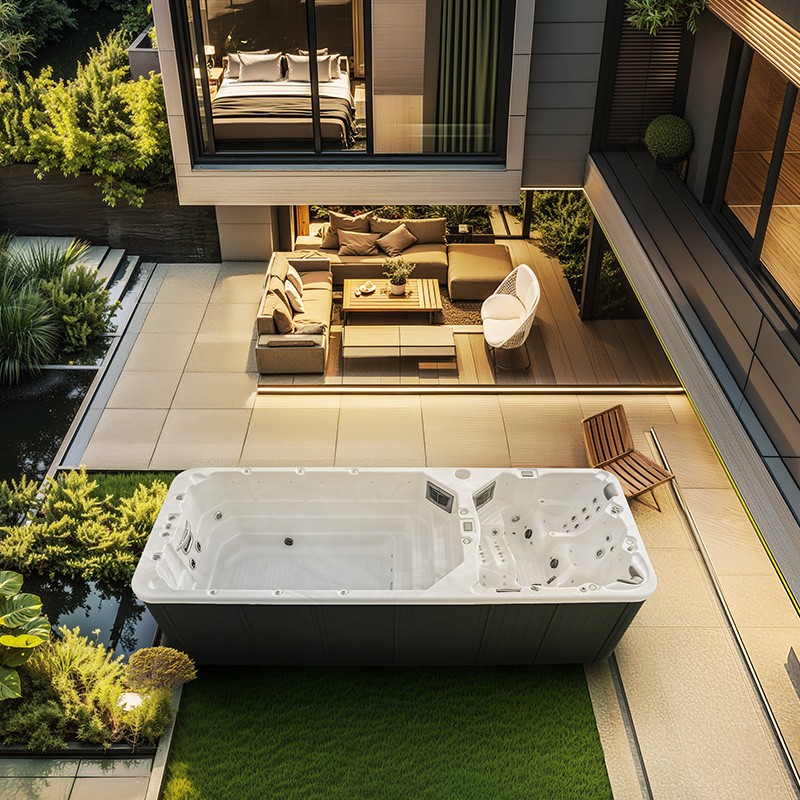
How long can a small outdoor hot tub maintain a 40°C water temperature?
2025-08-14 15:30A small outdoor hot tub not only provides a comfortable hydrotherapy experience but also helps relieve muscle fatigue and improve blood circulation, making it an essential amenity for a healthy lifestyle. For many users, the ability to maintain a 40°C temperature and provide a long, comfortable soaking experience is a key consideration in purchasing and using a spa hot tub.
So, the question is: How long can a small outdoor hot tub maintain its water temperature at 40°C? We will analyze this question from multiple perspectives to provide consumers with an accurate answer.
What factors affect the water temperature maintenance time of a small outdoor hot tub?
1. Ambient temperature
The water temperature maintenance time of a small outdoor hot tub is closely related to the ambient temperature. If the ambient temperature is low, the water temperature in the spa hot tub will gradually drop due to heat loss. Especially in cold winter months, the water temperature will drop faster than in warm summer months.
This is because water loses heat primarily through contact with the air and through the surface of the outdoor hot tub. When the ambient temperature is low, the water loses heat more rapidly, causing the temperature to drop more rapidly.
2. Bathtub Material
The material of a small outdoor hot tub also significantly affects how long the water maintains its temperature. Different bathtub materials have different thermal conductivity. Generally speaking, materials with good thermal insulation, such as acrylic and polyurethane foam, can effectively reduce heat loss and prolong the water's temperature retention.
On the other hand, thinner, less insulative bathtub materials will cause heat loss more quickly, causing the water temperature to drop more quickly. The thickness of the bathtub's insulation also directly affects its heat retention efficiency. Thicker insulation can effectively extend the water's temperature retention time.
3. Efficiency of the spa hot tub's heating system
The efficiency of a small outdoor hot tub's heating system is also a key factor in determining how long the water maintains its temperature. Most small outdoor hot tubs are equipped with a heater. When the water temperature drops below a certain level, the heating system activates, using electricity or gas to heat the water to maintain the set temperature within the specified range.
If the heating system has a high power rating and good heating efficiency, a small outdoor hot tub can quickly heat the water to 40°C and quickly replenish heat when the water temperature drops, thus maintaining the desired temperature for a longer period of time.
4. Pump and Nozzle Use
The pump and nozzles in a small outdoor hot tub, while providing massage functions, may also cause the water to lose temperature more rapidly. This is especially true when using high-flow settings, as the increased water flow increases the rate of heat loss. This is because the strong water flow provided by the pump and nozzles increases the contact area between the water and the air, accelerating heat loss.
Therefore, if the pump and nozzles are continuously active during use, the water temperature will be maintained for a shorter period of time than when these functions are turned off.
5. Water Volume
The water volume of a small outdoor hot tub directly affects how long the water maintains its temperature. Smaller tubs have a relatively small water volume, so after heating to 40°C, the water has less heat and is more susceptible to external environmental influences. Larger tubs, on the other hand, have more water volume and a greater heat reserve, allowing them to maintain their water temperature for a longer period of time.
Of course, larger tubs require a more powerful heating system to maintain the high temperature, so they may take longer to heat up.
6. Wind Speed and Direct Sunlight
The strength of wind in outdoor environments is also a significant factor affecting how long water temperature is maintained. Strong winds accelerate evaporation from the water surface and increase heat loss. Cold winter winds, in particular, can cause the water temperature to drop even faster. Similarly, direct sunlight can also have a certain impact on water temperature.
In strong sunlight, while it can provide a certain amount of heat to the tub, excessive exposure can accelerate evaporation from the water surface and heat loss, affecting the ability of an outdoor hot tub to maintain its temperature.

How to calculate how long a small outdoor hot tub can maintain a 40°C water temperature?
1. Water Heat Capacity
The heat capacity of water refers to its ability to absorb and release heat. The energy required to heat each liter of water by 1°C is approximately 4.18 kilojoules (kJ). In other words, water's heat storage capacity is closely related to its volume and temperature change. Under ideal conditions, assuming no external heat loss, we can estimate the heat storage capacity of the outdoor hot tub by calculating its volume and, therefore, how long it can maintain a 40°C water temperature.
For example, assume a small outdoor hot tub has a capacity of 1000 liters, the set water temperature is 40°C, and the ambient temperature is 20°C. In this scenario, the bathtub needs to heat 1000 liters of water from 20°C to 40°C. The heat required is calculated as: Q = "m × c × ΔTQ".
Where:
· "Q" is the heat (kJ)
· "m" is the mass of the water (kg)
· "c" is the specific heat capacity of water (4.18 kJ/kg·°C)
· "ΔTQ" is the temperature difference (40°C - 20°C = 20°C)
· For 1000 liters of water (or 1000 kg), the heat required is: Q = 1000 × 4.18 × 20 = 83,600 kJQ
If the outdoor hot tub's heating system has a power of 6 kW (6000 watts), the time required to heat the water is: Heating time = 83,600 × 6,000 = 13.93 hours
However, this is only the time required for heating, not the time the water maintains its temperature. The actual water temperature retention time is affected by factors such as heat dissipation, the external environment, and the tub material, so the actual retention time is usually shorter.
2. External Heat Loss Rate
In addition to the water's inherent heat capacity, the external heat loss rate is also a significant factor. During use, the water in an outdoor hot tub loses heat through contact with the air, heat dissipation from the tub surface, and evaporation. If the ambient temperature is low or the wind speed is high, heat loss is accelerated, causing the water temperature to drop more quickly.
Depending on environmental factors, the water temperature retention time may be reduced from several hours to 1-2 hours.

How to Extend the Water Temperature Retention Time of a Small Outdoor Hot Tub?
While water temperature retention time is affected by a variety of factors, outdoor hot tub users can effectively extend the water's temperature retention time by taking a few measures:
1. Installing High-Efficiency Insulation
Choosing a tub material with good thermal insulation properties, such as polyurethane foam, acrylic, or expanded foam, can effectively reduce heat loss. In addition, using an insulating cover or hood to cover the bathtub surface can also reduce evaporation and heat loss from the water surface, thereby extending the duration of water temperature retention.
2. Control Frequency of Use
Avoiding prolonged, continuous use of your outdoor hot tub, especially with strong water flow or high-power heating settings, can effectively reduce heat loss. If used lightly or occasionally, the water in the tub will maintain its temperature for a longer period of time.
3. Adjust Heating System Settings
By adjusting the heating system's power and temperature settings, ensure that heat is replenished promptly when the water temperature drops to a certain level, preventing discomfort caused by excessively low water temperatures. Proper configuration and management of the heating system will help improve water temperature maintenance efficiency.
4. Avoid Strong Winds When Using the Bathtub
Avoid using the bathtub in strong winds or install it in a more enclosed location to minimize the direct impact of wind. Excessive wind speeds can accelerate heat loss, causing the water temperature to drop rapidly.

How do your spa products compare in quality and price to other suppliers?
As one of the largest outdoor spa and swim spa manufacturers in China, we pride ourselves on offering the perfect balance between affordable prices and premium build quality. Our spa products use internationally recognized components and undergo strict quality control, meeting CE, ETL, ROHS, and ISO9001 certifications.
Compared to other suppliers, our factory-direct prices, volume discounts, and custom options make us a preferred choice for both retail and wholesale purchasing.

